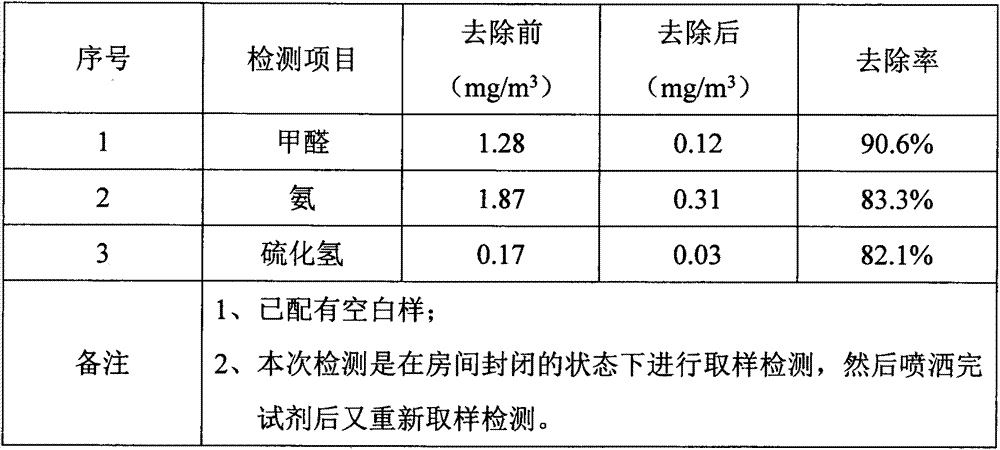Indoor air purificant and preparation method thereof
A technology for indoor air and purifiers, applied in chemical instruments and methods, separation methods, atomized substances, etc., can solve problems such as impossibility, secondary pollution, and removal of indoor air pollution, and achieve convenient and safe use, long duration, Simple operation effect
- Summary
- Abstract
- Description
- Claims
- Application Information
AI Technical Summary
Problems solved by technology
Method used
Image
Examples
Embodiment 1
[0026] Indoor air purifier among the present invention by following weight proportion:
[0027] Propylene Glycol 20%;
[0028] Hydrogenated Castor Oil 10%;
[0029] Modified Hydrogenated Castor Oil 10%;
[0030] denatured alcohol 5%;
[0031] Pinene 5%;
[0032] Menthane 5%;
[0033] Benzyl acetate 5%;
[0034] Lauryl Alcohol 5%;
[0035] Vanillin 5%;
[0036] Methylchloroisothiazolinone 0.05%;
[0037] Methylisothiazolinone 0.05%;
[0038] Fragrance 0.05%;
[0039] EDTA 0.05%;
[0040] Cocamidopropyl Betaine 0.05%;
[0041] The remaining 27.5% is distilled water.
[0042] The preparation method of the indoor air purifier is carried out as follows: hydrogenated castor oil, modified hydrogenated castor oil, propylene glycol and cocamidopropyl betaine are added to distilled water in sequence, heated to 90 ° C, and continuously stirred during the heating process. After keeping at 90°C for 1 hour, the temperature was lowered to 30°C to form a cooling liquid. Add dena...
Embodiment 2
[0044] Formaldehyde, hydrogen sulfide, ammonia removal rate experiment
[0045] After the finished product is made, the laboratory removal rate experiments of formaldehyde, hydrogen sulfide and ammonia are started respectively. Evenly volatilize the prepared standard solution to 5m 3 closed space. Prepare a nozzle with a certain flow rate and fix the air flow at 17.4m 3 / h, the flow rate is fixed at 1.5cm / s, and an appropriate amount of indoor air purifier is sprayed into the space. Close for 30 minutes after spraying. Samples are then taken and analyzed by testing instruments.
[0046] Table 1 The removal rate of formaldehyde, ammonia and hydrogen sulfide
[0047]
[0048] It can be drawn from Table 1 that the present invention can remove formaldehyde, ammonia, and hydrogen sulfide, and prove that the present invention has obvious treatment effects on formaldehyde, ammonia, and hydrogen sulfide.
[0049] The invention can make the removal rate of formaldehyde, ammoni...
PUM
 Login to View More
Login to View More Abstract
Description
Claims
Application Information
 Login to View More
Login to View More - R&D
- Intellectual Property
- Life Sciences
- Materials
- Tech Scout
- Unparalleled Data Quality
- Higher Quality Content
- 60% Fewer Hallucinations
Browse by: Latest US Patents, China's latest patents, Technical Efficacy Thesaurus, Application Domain, Technology Topic, Popular Technical Reports.
© 2025 PatSnap. All rights reserved.Legal|Privacy policy|Modern Slavery Act Transparency Statement|Sitemap|About US| Contact US: help@patsnap.com

